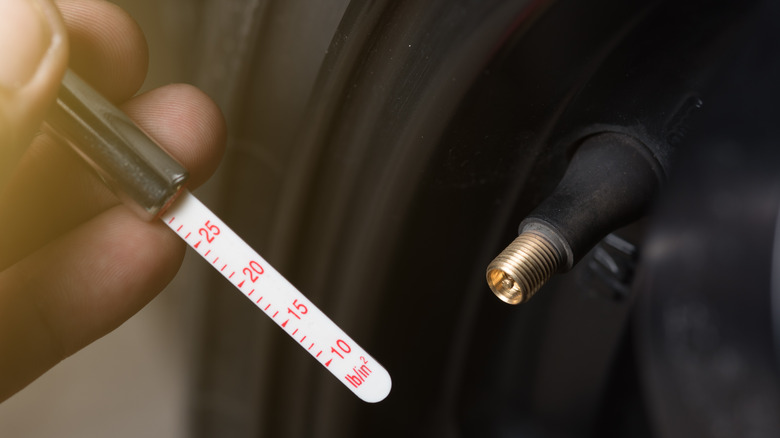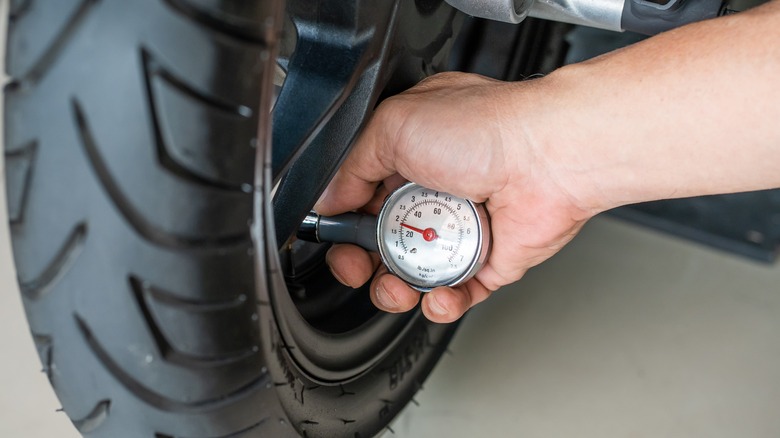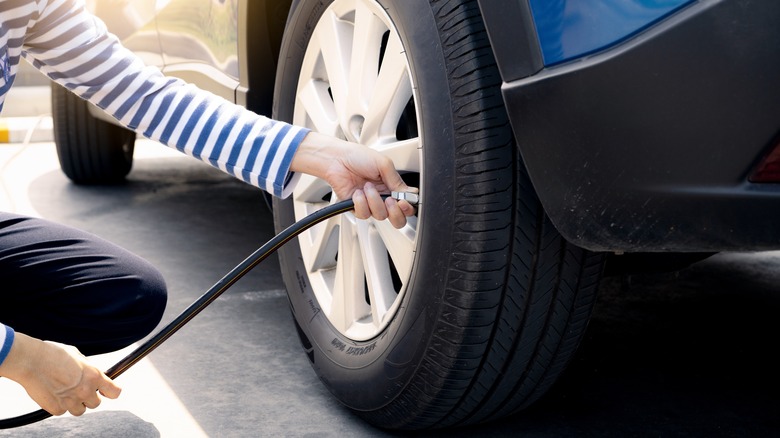How To Properly Use And Check Your Car's Tire Pressure With A Gauge
As far as routine auto maintenance goes, it's common knowledge that changing your oil, rotating your tires, and replacing filters can not only lengthen the life of your engine but also help increase fuel efficiency. Most car owners would, of course, require the assistance of an automotive professional for those maintenance services. You may not realize it, but you can also dramatically affect your vehicle's fuel efficiency without a trip to a mechanic by monitoring the air pressure in your tires.
On top of potentially boosting your car's miles per gallon average, checking and maintaining your air pressure can also extend the life of your tire and contribute to a smoother overall ride. Perhaps more important than that news is that you can keep track of your vehicle's tire pressure simply by purchasing a tire pressure gauge, which you can do for anywhere between $6 and $20 at an auto store or through various online retailers. Of course, once you buy a tire pressure gauge, you need to learn to use it.
As air pressure may increase in your tires when they are warm, it is recommended that you check the pressure when the tires are cold for an accurate reading. Consult an automotive professional if you are having trouble keeping your tires inflated.
Here's how to check your car's tire pressure with a gauge.
How to check your tire pressure with a gauge
Tire pressure is measured in PSI (pounds per square inch), and you will need to learn the recommended PSI for your tires before you begin, as this information can help discern if they are over-inflated or under-inflated. The PSI recommendations can often be found on the tire itself in the guise of a number followed by the letters PSI, though you can likely also find the information in your vehicle's owner's manual. Once you know the target PSI for your tires, follow these steps to check the air pressure:
- Locate the air valve on your tire (the little stem-like protrusion in the rim) and remove the cap.
- Insert the tip of the air valve into the open end of your tire pressure gauge, ensuring no air is escaping. If you hear a hissing sound, you will need to adjust.
- With a tight seal on the valve, the tire's air pressure will show on the connected gauge. Digital gauges will display a number, while some analog gauges may have a dial with a needle pointing at the tire's PSI number. On a classic tire pressure gauge, the air pressure pushes a small, numbered bar out from inside, with the tire's PSI showing where the rod meets the gauge's casing.
- Write down the PSI for each tire to know how much to inflate or deflate each.
How to inflate or deflate your tires
After determining your tires' PSI, you might need to inflate or deflate each to reach the recommended amount of pressure. To inflate a tire, you will need an inflator, which can be purchased for as low as $30 on Amazon. You can also find a top-rated tire inflator at most service stations, which will cost just a few dollars, depending on how much air you use. With an inflator handy, here's how to increase the air in your tires:
- Locate the air valve on your tire and remove the cap.
- Turn the inflator on and connect it to the air valve. Make sure there is no loss of air in the connection.
- Air should begin entering the tire once connected.
- Monitor the tire's pressure using your tire pressure gauge or one connected to the inflation device you are using. Disconnect when the target PSI is reached.
- Replace the air valve cap, and you're finished.
To deflate your tires, you can apply pressure to the little stem inside the tire's air valve to release air. It is highly recommended to use a tire deflation tool (about $16 for a kit). Likewise, some inflators also have a deflation function, making the process as easy as setting the desired number on the device. However you proceed, closely monitor the PSI with your tire pressure gauge as the tire deflates, stopping when you reach the desired number.


